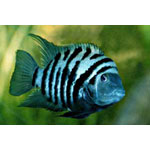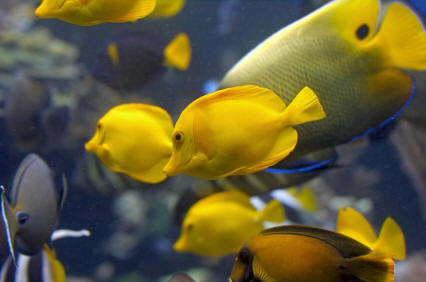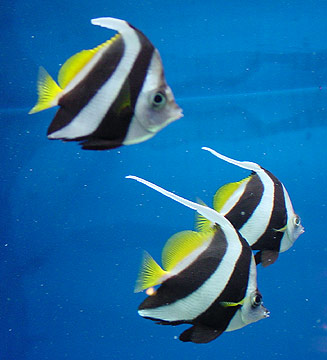Zebra Convict Cichlid

|
Scientific Name: Amatitlania nigrofasciata Price: Upon Request Origin: Central America Family: Cichlidae NOT AVAILABLE NOW |
|
Other Names: Convict Cichlid, Cichlasoma nigrofasciatum, Cryptoheros nigrofasciatus, Archocentrus nigrofasciatus |
|
Technical Info
Temperature: 24 - 27 ℃
pH: 6 - 8
GH: 5 - 15
Max size: 15 cm
Min Tank size: 100 Ltr
Position in Aqua: No special swimming level
Description
The Zebra Convict Cichlid has a blue-gray, cream, or blue-lavendar base on the body with 8 to 9 dark bands that run vertically. They have a break in the vertical bands in the area behind their head, almost forming a "U" shape. The fins are clearish to light yellow. With in-line breeding there are now several color varieties, and some of the cream and "pink" varieties lack the vertical bars.
Food
The Zebra Convict Cichlid is omnivorous and will eat most prepared and frozen foods, including freeze-dried bloodworms, tubifex, and ocean plankton, as well as flake food and Cichlid pellets.
Breeding
Very easy to breed them and they are great parents. Provide a clay or plastic type of cave (flower pot) and they should pair up assuming you have a male and female. They should place the eggs on the walls or top of the flower pot. Eggs should hatch within 3 to 4 days and the parents may relocate them to a pit where they can watch over them. Another 4 to 5 days later they should be free swimming and you should feed them crushed flake food and/or brine shrimp.
Compatible with
The Convict Cichlid is an aggressive cichlid that can only be kept with larger fish that have the same temperament. The Blue Acara, Rainbow Cichlid, Jack Dempsey, and Green Terror are the type of fish they won't terrorize to death. Do not house with fish that are only just semi-aggressive or fish large enough to swallow them whole. Once they are mating they will kill anything in the tank if they can. They have been known to beat up large plecostomus and Oscars 3 times larger than themselves! This fish can be kept alone, resulting in a slightly skittish and more mellow fish, or as a male and female pair. They are generally aggressive toward those of the same species especially when mating.
Note
Males may be larger than females of the same age. Females usually have pink or orange on the belly. Males may have longer dorsal fins.

